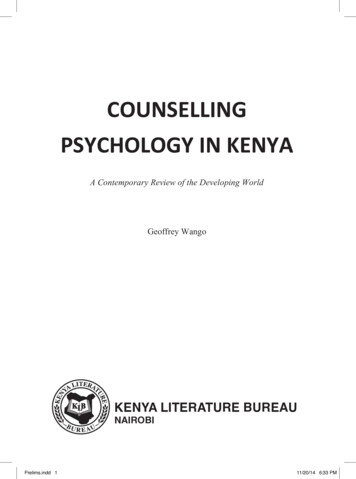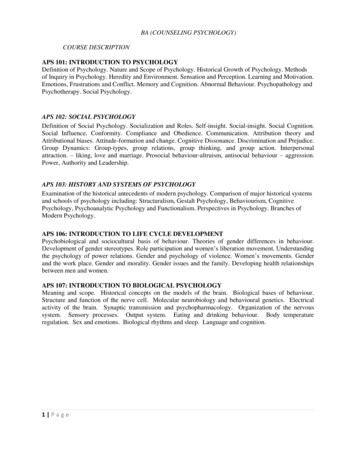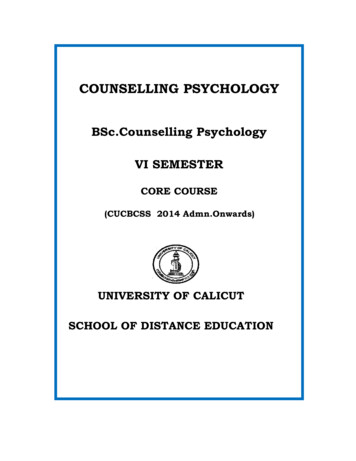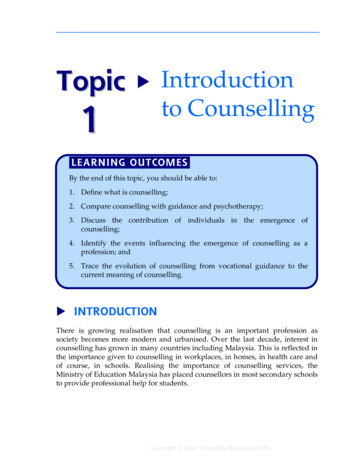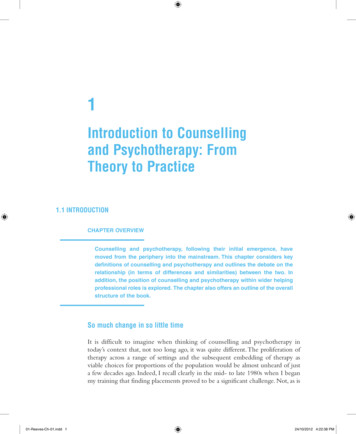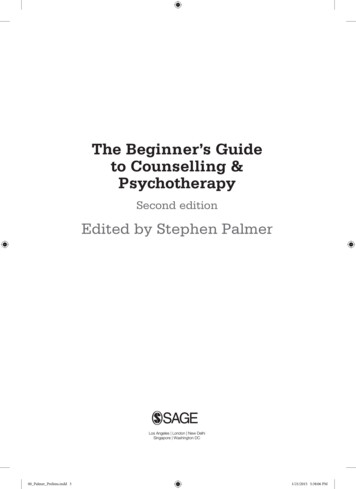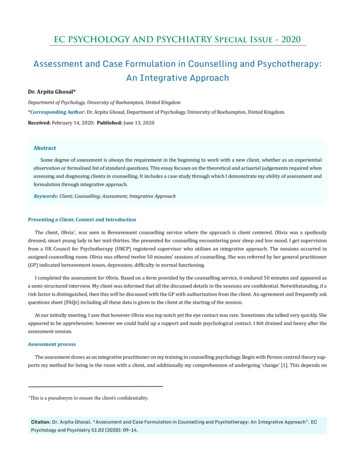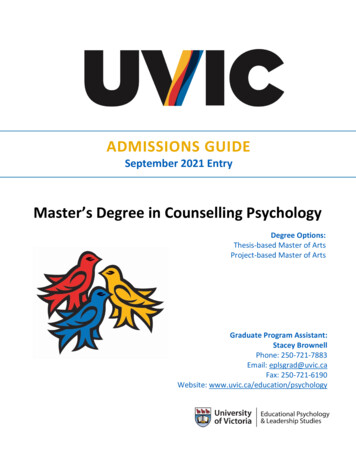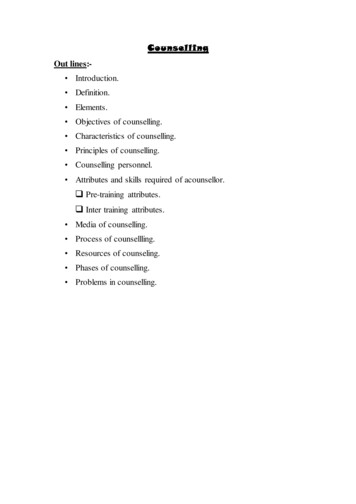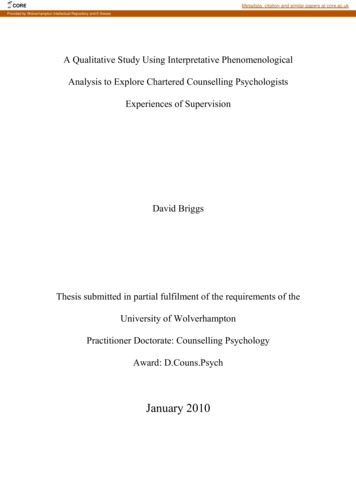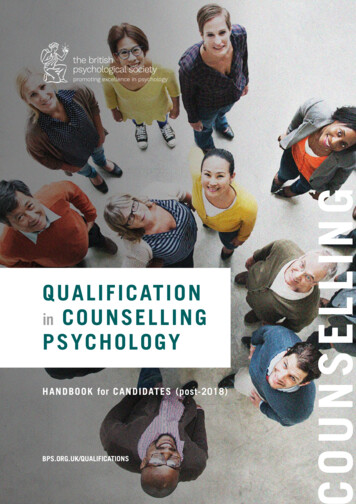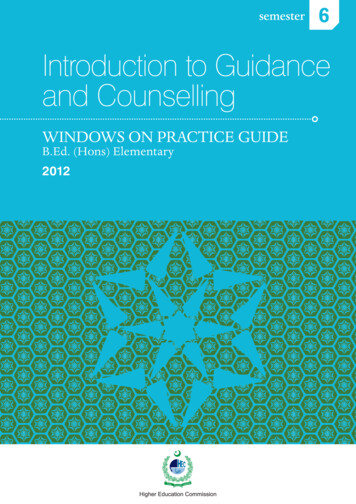
Transcription
semester6Introduction to Guidanceand CounsellingWINDOWS ON PRACTICE GUIDEB.Ed. (Hons) Elementary2012
This product has been made possible by the support of the American People through the United States Agency forInternational Development (USAID). The contents of this report are the sole responsibility of the authors, and donot necessarily reflect the views of USAID or the United States Government.Technical Support: Education Development Center (EDC); Teachers College, Columbia University
ForewordTeacher education in Pakistan is leaping into the future. This updated Scheme of Studies is the latestmilestone in a journey that began in earnest in 2006 with the development of a National Curriculum,which was later augmented by the 2008 National Professional Standards for Teachers in Pakistan andthe 2010 Curriculum of Education Scheme of Studies. With these foundations in place, the HigherEducation Commission (HEC) and the USAID Teacher Education Project engaged faculty across thenation to develop detailed syllabi and course guides for the four-year B.Ed. (Hons) Elementary and thetwo-year Associate Degree in Education (ADE).The syllabi and course guides have been reviewed by the National Curriculum Review Committee(NCRC ) and the syllabi are approved as the updated Scheme of Studies for the ADE and B.Ed. (Hons)Elementary programmes.As an educator, I am especially inspired by the creativity and engagement of this updated Scheme ofStudies. It offers the potential for a seismic change in how we educate our teachers and ultimately ourcountry’s youngsters. Colleges and universities that use programmes like these provide their studentswith the universally valuable tools of critical thinking, hands-on learning, and collaborative study.I am grateful to all who have contributed to this exciting process; in particular the faculty and stafffrom universities, colleges, and provincial institutions who gave freely of their time and expertise forthe purpose of preparing teachers with the knowledge, skills, and dispositions required for nurturingstudents in elementary grades. Their contributions to improving the quality of basic education inPakistan are incalculable. I would also like to thank the distinguished NCRC members, who helpedfurther enrich the curricula by their recommendations. The generous support received from theUnited States Agency for International Development (USAID) enabled HEC to draw on technicalassistance and subject-matter expertise of the scholars at Education Development Center, Inc., andTeachers College, Columbia University. Together, this partnership has produced a vitally importantresource for Pakistan.PROF. DR SOHAIL NAQVIExecutive DirectorHigher Education CommissionIslamabadB.ED. (HONS) ELEMENTARYii
How the Windows on Practiceguide was developedAs part of nationwide reforms to improve the quality of teacher education, theHigher Education Commission (HEC), with technical assistance from the USAIDTeacher Education Project, engaged faculty across the nation to develop detailedsyllabi for courses in the new four-year B.Ed. (Hons) Elementary programme.The process of designing the syllabus for each course in years 3–4 of theprogramme began with curriculum design workshops. Deans and directorsfrom universities where these courses will be taught were invited to attend theworkshops. In the first workshop, national and international subject matter expertsled participants in a seminar focused on a review and update of subject (content)knowledge. The remainder of this workshop was spent reviewing the HECScheme of Studies, organizing course content across the semester, developingdetailed unit descriptions, and preparing the course syllabi. Although the coursesyllabi are designed primarily for Student Teachers taking the course, they areuseful resources for teacher educators too.Following the initial workshop, faculty participants developed teaching notesthat include ideas for teaching units of study and related resources. Workingindividually or in groups, participants focused on their own teaching methodsand strategies and how these could be useful to future teachers of the course.Subsequent workshops were held over the course of a year to give faculty sufficienttime to complete their work, engage in peer review, and receive critical feedbackfrom national and international consultants. In designing both the syllabi and theteaching notes, faculty and subject matter experts were guided by the NationalProfessional Standards for Teachers in Pakistan (2009).All of the syllabi developed by faculty who participated in the workshops areincluded in this document, along with a list of topical teaching notes. Additionalreferences and resources appear at the end of the document. These should providea rich resource for faculty who will teach this course in the future. Sample syllabiwith accompanying teaching notes are also included to provide new Instructorswith a model for developing curricula and planning to teach. This Windows onPractice guide is not intended to provide a complete curriculum with a standardsyllabus and fully developed units of study, but rather aims to suggest ideas andresources for Instructors to use in their own planning. Hence, readers will findsample units and materials that reflect the perspective of faculty designers ratherthan prescriptions for practice.iiiHOW THIS COURSE GUIDE WAS DEVELOPED
We respect intellectual property rights and to the best of our knowledge, we havenot included any suggested materials that are copyright protected or for which wehave not secured explicit permission to use. Therefore, all materials included maybe used in classrooms for educational purposes. Materials in this document are notintended for commercial use, however. They may not be used in other publicationswithout securing permission for their use.Initial drafts were reviewed by the National Curriculum Review Committee(NCRC) and suggestions were incorporated into final drafts, which were thensubmitted to the NCRC for approval.Faculty involved in course design: Abid Hussain Chaudry, Punjab University,Lahore; Dr Ali Murtaza, University of Azad Jammu and Kashmir, Muzzafarabad;Amir Bano, Allama Iqbal Open University, Islamabad; Liaquat Hussain, Instituteof Education and Research, Gomal University, Dera Ismail Khan, KhyberPakhtunkhwa; Maroof Bin Rauf, University of Karachi, Karachi; Mubeen AhmedLangah, Shah Abdul Latif University, Khairpur; Muhammad Nisar-ul-Haq,Karakoram International University, Skardu; Dr Muhammad Sarwar, University ofSargodha, Sargodha; Munazza Ambreen, Allama Iqbal Open University, Islamabad;Nida Mirza, University of Sindh, Jamshoro; Nadeem Khan, Institute of Educationand Research, University of Peshawar, Peshawar; Raqeeb Imtiaz, Universityof Gujrat, Gujrat; Dr Saddaf Ayub Raja, Fatima Jinnah Women University,Rawalpindi; Shahla Ambreen, Sardar Bahadur Khan University, Quetta; andZarghuna Naseem, University of Education, Lahore.National subject expert leading the seminar: Dr Anjum Kazmi, Dean of Education,Sindh Madressatul Islam University.National Curriculum Advisor who reviewed and compiled the Windows on Practiceguide: Martin Thomas, Faculty, Notre Dame Institute of Education, Karachi.NCRC review dates: 24 and 25 April 2013NCRC reviewers: Dr Asif, Faisalabad University, Faisalabad; Dr Javed Iqbal,Karakoram International University, Gilgit-Baltistan; and Dr Riasat Ali, KohatUniversity, Kohat.B.ED. (HONS) ELEMENTARYiv
Table of contents1Rationale for a course onguidance and counselling.7Common misconceptions aboutguidance and counselling.82Course syllabi. 10Syllabus 1: Maroof Bin Rauf, Nida Mirza, Raqeeb Imtiaz,Dr Saddaf Ayub Raja, and Shahla Ambreen . 11Syllabus 2: Amir Bano, Liaquat Hussain, Mubeen AhmedLangah, Muhammad Nisar-ul-Haq,and Munazza Ambreen . 203Representative syllabus with teaching notes. 28Dr Ali Murtaza, Zarghuna Naseem,Abid Hussain Chaudry,and Dr Muhammad Sarwar . 294Integrated teaching notes. 525References.646Readings and resources. 6777Methods and strategies to use in planning. 71
1Rationale for acourse on guidanceand counselling07COURSE SYLLABUS: Introduction to Guidance and Counselling
IntroductionIn the HEC 2010 document, Curriculum of Education: B.Ed. (Hons.) 4-year DegreeProgramme, Guidance and Counselling is added as a professional course. Teachersneed a basic knowledge of school guidance and counselling techniques to address thepersonal and social problems of students that they may encounter in the classroom.This course will assist Student Teachers in understanding the role of various membersof a guidance and counselling system in supporting students in addressing theirfuture and social challenges. They will master the basic skills of school guidanceand counselling by practicing these skills during their sessions. The course will alsoincrease their ability to exercise active listening skills, reflect on students’ concerns,assist students in arriving at solutions to problems, advise them on potential solutionsto stated problems, and make responsible social choices and informed decisions.Common misconceptions aboutguidance and counsellingIt is anticipated that Student Teachers studying the Guidance and Counselling coursewill hold a number of misconceptions about guidance and counselling. CourseInstructors need to be aware of such misconceptions, which are commonly sharedby the public, so that they can help Student Teachers confront and critique thesemisconceptions. Some of the important misconceptions are listed below: Guidance and counselling deal only with severe psychological problems and,hence, are not required for schoolchildren. When dealing with schoolchildren, there is not much relationship between thetheory and practical aspects of guidance and counselling. Guidance is always provided in group form, as many students have more orless similar issues on which they need guidance. Counselling is always counselee-centred, and the counselee plays aproactive role. There is a single theory of guidance and counselling that can be applied to allscenarios. Counselling is a complex process that can only be facilitated by professionalexperts. A teacher cannot be a counsellor. Every teacher can be a counsellor without undergoing any counselling training,as it does not require specific skills. Counselling cannot be given in a classroom situation because it involves theutilization of various resources. Counselling for personal, emotional, and social problems is the responsibilityof the parents, not the teacher. Counselling is only for children who are experiencing problems, and not forchildren who are bright and happy at school. A counsellor can provide a readymade solution to all problems. Guidance is a service or process that should be employed to address anemergency situation.B.ED. (HONS) ELEMENTARY08
Counselling is for developed countries. Guidance programmes do not work in Pakistani society and schools. Counselling is concerned only with educational issues. No ethical issues are involved in counselling. Counselling is a one-meeting problem-solving strategy.Adapted from teaching notes by: Maroof Bin Rauf, Shahla Ambreen, Nida Mirza,Raqeeb Imtiaz, Dr Saddaf Ayub Raja, Munazza Ambreen, Mubeen Ahmed Langah,Muhammad Nisar-ul-Haq, Liaquat Hussain, Amir Bano, Dr Ali Murtaza, ZarghunaNaseem, Abid Hussain Chaudry, and Dr Muhammad Sarwar.09COURSE GUIDE: Introduction to Guidance and Counselling
2Course syllabiGUIDANCE AND COUNSELLINGB.ED. (HONS) ELEMENTARY10
GUIDANCE AND COUNSELLINGThis section contains syllabi that have been written by faculty or groups of faculty.Using the HEC Scheme of Studies for the course, they considered the balancebetween the demands of the subject itself, active learning pedagogies, their students,and the particular university milieu in which they work. The syllabi all reflect thesame key concepts and broad goals, but they vary in sequence and emphasis.COURSE SYLLABUS 1ByMaroof Bin Rauf, Shahla Ambreen, Nida Mirza, Raqeeb Imtiaz,and Dr Saddaf Ayub RajaYear and semesterYear 4, Semester 7Credit value3 credits (contact hours: 3 hours per week)PrerequisitesSuccessful completion of the Child Development and EducationalPsychology coursesCourse descriptionThis course has been designed to introduce the concept, scope, and theories thatgovern the process of guidance and counselling in education. It will enable StudentTeachers to identify areas of guidance and counselling at the elementary level.Through the knowledge and skills acquired from this course, they will be wellequipped to explore the talents and potential of their students, while preparing themfor life in the 21st century. The course will include both theoretical knowledge ofguidance and counselling and the development of Student Teachers’ counselling skills.It will strengthen their ability to exercise active listening skills, reflect on students’problems, and help them choose potential solutions to their problems. The coursewill also enable Student Teachers to design school-wide guidance and counsellingprogrammes.11COURSE GUIDE: Introduction to Guidance and Counselling
Course learning outcomesBy the end of this course, Student Teachers will be able to: demonstrate knowledge of the importance of guidance and counselling toteachers and students critically analyse the concepts, scope, and theories that govern the process ofguidance and counselling use the principles and functions of guidance and counselling to ensure a safelearning environment in school identify and apply different tools of data collection in different situations select and apply appropriate counselling techniques to solve students’ problems coordinate and communicate with various stakeholders in the process ofguidance and counselling.Teaching-learning strategiesThe course will include an interactive approach and active learning strategies, suchas brainstorming, discussions, case studies, and role plays. It should provide StudentTeachers with practical experience of identifying and providing better solutions toproblems in a classroom and school setting. The emphasis will be on a student-centredapproach in order to provide maximum opportunity for them to inquire, present,share their views, and take an active part in all classroom activities. In some sessions,interactive lectures will also be used.Unit 1: Introduction to guidanceand counsellingDuration of the unit: 3 weeksUnit descriptionThis unit will help Student Teachers learn and understand important areas ofeducational guidance and counselling, an Islamic perspective on guidance andcounselling, and its implementation in their professional life.Unit learning outcomesBy the end of this unit, Student Teachers will be able to:lldifferentiate between guidance and counsellingllanalyse critically the concept of guidance and counselling from an Islamicperspectivellidentify principles that govern the guidance and counselling processlllist the main objectives of guidance and counselling programmes in educationllexplore various types of guidance and counselling.B.ED. (HONS) ELEMENTARY12
Essential knowledgeEssential knowledge for course Instructors in this unit includes background knowledgeof child development; related theories, especially regarding emotional development;educational psychology; and the scope of guidance and counselling.1UNIT 1:Introduction to guidance andcounsellingWeek #Session topics/chapterTeaching strategy1Session 1Introduction to guidance and counsellinggroup workinteractive lectureself-reflectionbrainstorming1Session 2The basic concepts of guidance andcounselling: Guidance, counselling, andpsychotherapygroup workoral presentationdiscussionindividual reading1Session 3The Islamic concept of guidance andcounsellingshort lectureindividual readingpair-share work2Session 4The scope of guidance and counselling:Community, family, administration, and peerscompleting storiesskit-writingpresentation2Session 5Principles of guidance and counsellinggroup discussionself-reflectionwriting specimen2Session 6Types of guidance and counselling:Educational and personaldiscussionbrainstormingreflection3Session 7Types of guidance and counselling: Socialand vocationalvideo ns 8 and 9Theories of guidance and counselling Carl Roger Erik Erikson Alfred Adler B. F. Skinnerinteractive lecturehandoutsconcept noteUnit assessmentThis unit is based on content knowledge; therefore, Student Teachers can be assessedin several ways, including questions and answers in classroom practice, quizzes, miniassignments, and presentations.13COURSE GUIDE: Introduction to Guidance and Counselling
ReferencesButcher, P. A. (2005). Sociology (9th ed.). Boston: McGraw-Hill.Hurlock, E. B. (2008). Developmental psychology (5th ed.). London: McGraw-Hill.Nayak, A. K. (2007). Guidance and counselling. New Delhi: APH Publishing.Shaffer, D. R., & Kipp, K. (2010). Developmental psychology: Childhoodand adolescence (8th ed.). Belmont: Wadsworth.Unit 2: The course instructoras a counsellorDuration of the unit: 3 weeksUnit descriptionThis unit will help Student Teachers understand the importance of guidance andcounselling in educational discipline. They will be encouraged to implement guidanceservices in different situations. It will also help them to understand not only therequired qualities of a good counsellor but also the related ethical considerations.Unit learning outcomesBy the end of this unit, Student Teachers will be able to:llcritically analyse the role of a teacher as a guide in schoollldifferentiate among various guidance servicesllidentify various qualities of a teacher necessary for a counselling rolelldiscuss the different counselling services that a teacher can provide to studentslldemonstrate knowledge of the ethical considerations related to guidance andcounselling services.Essential knowledgeThe basic purpose of a guidance and counselling programme is to ensure the physical,emotional, social, and educational development of learners. Since primary schoolstudents spend most of the school day with just a few teachers, these teachers are ina favourable position to perform their role as a counsellor for their students. Theycan assume their counselling role at two levels – school and classroom. At schoollevel, their role as counsellor will be oriented towards the more general and commonproblems of primary schoolchildren. In contrast, their role as classroom counsellorwill be slanted towards the more specific and individual problems of their students.B.ED. (HONS) ELEMENTARY14
2UNIT 2:The course instructor as a counsellorWeek #Session topics/chapterTeaching strategy4Session 10Qualities of a counsellor: Personaland professionalgroup workself-analysis4Sessions 11 and 12Guidance services that a teacher can providemultimedia presentationdiscussionrole play5Sessions 13 and 14The teacher as an agent of change: Problemsin the classroom for guidance and counsellinganalysis of the contentindividual workconcept paper5Session 15The teacher as an agent of change: Issues inschool for changeinteractive dissociationwriting activity6Session 16The role of a teacher as a counsellorin classroom for improving solvingself reading6Session 17The role of a teacher as a change agentin schoolbrainstormingreadingproblem-solvingSession 18Ethical considerations of guidance andcounsellinginteractive lecturingmultimedia presentation ofnews cuttingsgroup discussionpanel discussion6Unit assessmentThis unit can be assessed using a quiz and a small-scale project in which StudentTeachers, in groups, identify classroom problems that require counselling, suchas aggressive behaviour, shy and withdrawing children, slow learners, fear andanxiety, attendance problems, and so forth. In groups, Student Teachers will planout strategies for solving problems identified by their group and then present them.In this project, Student Teachers can be assessed for their group harmony andparticipation. Secondly, they can be assessed for the authenticity of their identifiedclassroom problems and suggested strategies for the solution of these problems.ReferencesNayak, A. K. (2007). Guidance and counselling. New Delhi: APH Publishing.Thompson, R. A. (2012). Professional school counseling: Best practices for working in theschools (3rd ed.). New York: Routledge.15COURSE GUIDE: Introduction to Guidance and Counselling
Unit 3: Procedures and tools forguidance and counsellingDuration of the unit: 3 weeksUnit descriptionThis unit deals with procedures and tools required in the process of guidance andcounselling. It aims to develop knowledge and skills among Student Teachers,so that they can identify students or cases in their classrooms and then selectappropriate strategies for intervention.Unit learning outcomesBy the end of this unit, Student Teachers will be able to:llillustrate and examine the procedures and steps involved in counsellingllidentify students who need counselling servicesllselect and devise appropriate strategies for interventions or problem-solvingllidentify various professionals to whom students with severe problems can bereferred.Essential knowledgeEssential knowledge for course Instructors in this unit includes theoreticalknowledge about procedures and steps of counselling and tools and strategies forcollecting information and solving problems, as well as practical knowledge toimplement these in different situations.3UNIT 3:Procedures and tools for guidance andcounsellingWeek #Session topics/chapterTeaching strategy7Sessions 19 and 20Steps and procedures of counsellingreading and discussionmaterial, case studies,poster-writing7Session 21Strategies for solving problems or staginginterventionspanel discussion, individualwork, group discussion8Sessions 22–24Techniques and strategies for problem-solving Observation Interview Cumulative recordout-of-class activity(observation), interactivelecturing, group work, roleplay, group presentations,spaceman analysis, gallerywalk, critical friends, pairshare work9Sessions 25 and 26 Questionnaire Case studygroup discussion, handoutsdramatization9Session 27Referring cases to the concerned professionalsgroup discussionindividual workB.ED. (HONS) ELEMENTARY16
Unit assessmentStudent Teachers’ understanding and skills can be assessed through quizzes, miniassignments, presentations, and a small-scale project in which they, in groups, identifyproblems in relevant schools related to academic, social, and intellectual capability, aswell as major academic problems of students at individual level.ReferencesOkum, B. F., & Kantrwitz, R. E. (2008). Effective helping: Interviewing and counselingtechniques (7th ed.). Belmont: Thomson.Perry, W. (2008). Basic counselling techniques: A beginning therapist’s toolkit (2nd ed.).Bloomington: Author House.Unit 4: School-wide guidanceand counsellingDuration of the unit: 7 weeksUnit descriptionThis unit aims to help Student Teachers understand and identify issues in the primaryschool setting for which guidance and counselling become necessary. It also aims toequip them with the knowledge and skills required for the effective implementation ofguidance and counselling programmes in a school setting.Unit learning outcomesBy the end of this unit, Student Teachers will be able to:llidentify issues and problems in schools for guidance and counsellinglldemonstrate the ability to initiate guidance and counselling programmes in aschool settinglldesign strategies for collaborating and communicating with various stakeholdersin guidance and counselling programmeslldesign a school development plan for implementing guidance and counsellingin an primary school setting.Essential knowledgeThe basic aim of a guidance and counselling programme is to help Student Teachersidentify problems or issues in schools, and then to develop a rationale for a guidanceand counselling programme in a school setting. This unit will provide comprehensiveknowledge about school-wide guidance and counselling programmes, which willencourage Student Teachers to use their creativity and fresh ideas to conceptualizetheir own guidance and counselling programmes in school. It will also develop theirability to perceive, respond to, and manage the whole spectrum of guidance andcounselling in schools through an action plan.17COURSE GUIDE: Introduction to Guidance and Counselling
4UNIT 4:School-wide guidance and counsellingWeek #Session topics/chapterTeaching strategy10Sessions 28 and 29Problems and issues in primary schools:Educational, social, physical, psychological,and careerinterviewquestionnaire10Session 30Initiating guidance programmes in schools:Needs assessmentimaginative thinking11Session 31Initiating guidance programmes in schools:Support structurejigsaw readinggroup discussion12Session 32Initiating guidance programmes in schools:Vision, mission, and goal-settingbrainstormingwritten workcritical review (critical friend)12Session 33Initiating guidance programmes in schools:Tasks and activitiesdesigning activitiesclass presentation12Session 34Initiating guidance programmes in schools:Assessment of guidance and counsellingprogrammesassessment plan13Session 35Involving various stakeholders in the guidanceprogramme: Parentspanel discussion13Session 36Involving various stakeholders in the guidanceprogramme: Communitylecturebrainstormingdiscussion13Sessions 37 and 38Visualizing action plans14Session 38 (continued)14Sessions 39 and 40Preparing an action plandiscussionpowerPoint presentation15Sessions 42 and 43 Emergency drills: Earthquake, fire,and bomb drills Traumatic stress managementpresentations and simulationson hypothetical scenarios,group work, role plays16Sessions 44–46Assigning responsibilitiesImplementation of action plan or doingactivityDocumentation and report-writingEvaluationFuture planuse of action plan templatesB.ED. (HONS) ELEMENTARY18
ReferencesBannister, C., & McInnes, B. (2005). RCN working well initiative guidance on traumaticstress management in the health care sector. Retrieved from:ØØ http://www.rcn.org.uk/ data/assets/pdf file/0009/78543/001804.pdfDougherty, A. M. (2009). Psychological consultation and collaboration in school andcommunity settings (5th ed.). Belmont: Brooks/Cole.Hederson, D. A., & Thompson, C. L. (2011). Counseling children (8th ed.). Belmont:Cengage Learning.NDMA (National Disaster Management Authority). (2007). National disaster riskmanagement framework Pakistan. Islamabad: NDMA, Government of Pakistan.Retrieved from:ØØ if, R. S. (2009). Applying career development theory to counseling (5th ed.). Stanford:Brooks/Cole.Zunkar, V. G. (2006). Career counseling: A holistic approach (7th ed.). Belmont: Brooks/Cole.19COURSE GUIDE: Introduction to Guidance and Counselling
COURSE SYLLABUS 2ByMunazza Ambreen, Mubeen Ahmed Langah, Muhammad Nisar-ul-Haq,Liaquat Hussain, and Amir BanoYear and semesterYear 4, Semester 7Credit value3 credits (contact hours: 3 hours per week)PrerequisitesSuccessful completion of the Child Development and EducationalPsychology coursesCourse descriptionThis is a compulsory course in the B.Ed. (Hons) programme. It is designed to giveteachers and other stakeholders an in-depth understanding of the ideas of guidanceand counselling. It also covers trends and issues, including an Islamic perspective, aglobal perspective, and challenges of the 21st century. The major focus is on howthese concepts are applied to students to maximize their learning by resolvingtheir issues and to develop them as balanced personalities. The course coversan introduction to guidance and counselling, the major areas in which guidanceis provided to schoolchildren, and different theories, types, and techniques ofcounselling. Student Teachers will be equipped with the skills and qualities of acounsellor, so that they can effectively perform this function in schools in particularand more generally in society. Finally, the action plan is included to prepare StudentTeachers to perform counselling functions in real-life situations.Course learning outcomesAfter studying this course, Student Teachers will be able to: define different concepts associated with the field of guidance and counselling,as well as different trends in and perspectives on guidance and counselling inrelation to the present scenario identify different guidance and counselling needs and provide appropriateservices in the educational, vocational, and social life of students develop and demonstrate the attributes and qualities of a good counsellor utilize appropriate techniques in the light of counselling theories in aneducational setting develop mechanisms for establishing guidance and counselling services intheir institutions implement the action plan in collaboration with internal and externalstakeholders of their institutions.B.ED. (HONS) ELEMENTARY20
Teaching and learning strategiesThe following learning and teaching strategies will be used: Interactive lecture method Demonstrations Inquiry approach Group discussions Fieldwork Library assignment Project work Individual assignment or self-study HandoutsUnit 1: Introduction to guidance andcounsellingDuration of the unit: 3 weeksUnit descriptionThis course is designed to give Student Teachers an overview
Psychology courses. Course description This course has been designed to introduce the concept, scope, and theories that . govern the process of guidance and counselling in educatio
